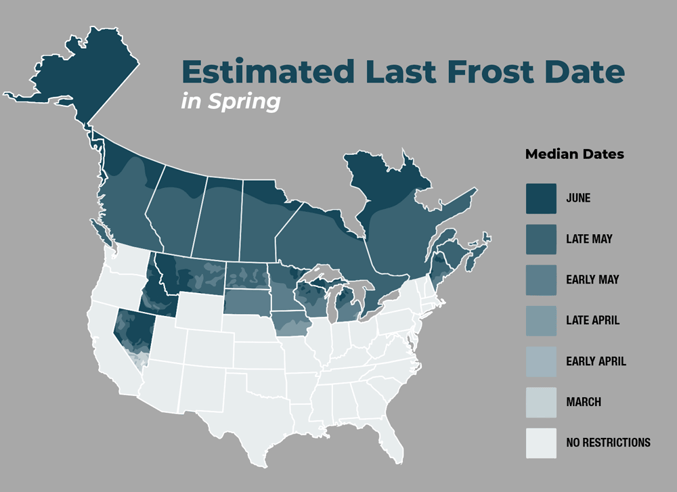As someone who's responsible for shipping and logistics, you're well-versed in the many factors that can impact your ability to transport goods from point A to point B.
For example, during the winter months, blizzards and ice in the northernmost states may impact your shipping schedule.
But did you know there's another factor that could impact your deliveries as winter transitions into spring?
Even after the frost subsides, the spring thaw can affect the cost and timing of your shipments. Some states and provinces enact seasonal load restrictions during this time to prevent damage to roadways, and these "frost laws" can complicate the movement of your freight.
As one of the leading over-dimensional and heavy haul carriers in North America, Anderson Trucking Service (ATS) has experienced many spring thaw seasons in our 70 years in the industry. We understand the complexities of frost laws as well as the nuances of navigating them.
In this article, we'll explain spring thaw, how it can impact your shipments, and what you can do to prevent spring road conditions from negatively impacting your supply chain.
You'll walk away better prepared to manage your freight movements and continue fulfilling your obligation to your customers this spring.
Spring Thaw Explained
Throughout the winter months, prolonged periods of freezing and subzero temperatures cause roadbeds to freeze and contract.
Then spring arrives, and temperatures start to rise above freezing during the day. The asphalt expands, and the melting ice seeps into the roadway’s foundation.
At night, temperatures drop, and the asphalt contracts once again. This daily cycle of thawing leaves roadways soft and susceptible to cracks and breakage.

As you can imagine, large trucks with heavy loads can cause significant and expensive damage to these weakened roadways.
To prevent this damage to their vulnerable roadbeds, many northern states and provinces set seasonal restrictions on their roads.
How Do Frost Laws Work?
Spring thaw restrictions — also called "frost laws," "seasonal load restrictions," and "spring road bans," among many other terms — place a temporary limit on the weight and speed of vehicles on certain roads.
Very generally speaking, you can expect frost laws to begin taking effect in February or March, though specific timeframes vary depending on weather conditions and the state, county, and city in question.
These spring road restrictions can last weeks or months, depending on the region, but can typically be expected to start winding down in April or May.
There are no federal guidelines for thaw restrictions. Each jurisdiction sets its own regulations and their duration based on local climate patterns and road types.
The colder the weather, the deeper the freeze — which is why you may see more restrictions in northern states like Minnesota and North Dakota or provinces like Manitoba than in Ohio or Indiana.
In addition to state restrictions for interstates, local municipalities may have additional or differing restrictions for local road systems.
Which roads are affected in a given area comes down to their construction and condition. Some roads may have no restrictions, some will have restricted weight or speed, and some will have restrictions on both.
Likewise, just because one area's restrictions have already expired by the time your freight moves doesn't mean all areas are free of restrictions.

Complicating matters still, spring thaw restrictions are rarely consistent across state lines and international borders, which means shipments could be affected even if the cargo weight is as little as 40,000 pounds.
That’s right: Even legal loads can be impacted by seasonal weight restrictions.
Freight carriers take frost laws seriously, as the consequences for disobeying them can be significant. The penalty for being caught with an overweight load often includes costly fines and/or delays caused by mandatory offloading or redistributing of the load before travel can resume.
Shippers should take seasonal weight restrictions seriously, too. Failure to consider the seasonal rules in place along your shipments' routes can result in supply chain slow-downs and broken promises, which can degrade the quality of your relationships with your customers.
How Can Seasonal Weight Restrictions Affect Your Shipments?
The wide variety of restrictions from place to place makes it all but impossible for shippers to navigate them on their own, which is why working with a knowledgable transportation provider is key.
Without a partner helping you parse the nuances and solve the problems presented by spring thaw, you may end up dealing with any number of challenges alone — if you're able to complete your shipment at all.
Here are just a few ways that seasonal weight restrictions may impact your shipments if you do not prepare with the help of an expert:
- First-mile/Last-mile: Called the “first-mile” and “last-mile,” the highways and access roads that bookend your freight's journey may be small, but they can create mighty obstacles. Without expert insight into how your freight's first and last miles may be affected by spring thaw (and finding an alternate approach), you may find your shipment unable to move forward mere meters from your consignee's door.
- Cost: In some cases, you may be able to complete your shipment on roads currently under frost laws, but for an additional fee. For example, some jurisdictions may charge an extra rate per-mile for loads that exceed spring road ban weight limits.
- Distance: Spring thaw can also mean your shipments will take longer to deliver, as drivers will need to avoid certain states or road systems. For example, a shipment from Chicago, Illinois to Sioux Falls, South Dakota may actually double in distance to avoid traveling through Iowa or Minnesota.
With that said, not all transportation providers will have the same level of expertise in navigating frost laws.
Look for companies with extensive regulation knowledge, close relationships with state officials who can assist in making the right decisions, and ample experience moving freight in regions with seasonal load restrictions.
These are the carriers that will be able to intensively plan each route during the spring months to ensure your supply chain is as prepared as possible for the impact of frost bans.

What Can You Do to Limit the Impact of Seasonal Weight Restrictions?
Your customers are your top priority, and meeting their needs is essential to your ongoing success. But while spring thaw restrictions can throw a wrench in your logistics, there are a few things you can do to reduce your headaches and ensure you continue to meet your customers' needs:
- Be aware and proactive: Stay informed of all of the scenarios that can come into play throughout your shipment's journey and what it might take to comply. Also, learn about some of the remedies — like distributing weight across additional axles or breaking shipments up into additional loads.
- Plan for lengthier shipment times and extra costs: When spring thaw season arrives, recognize that getting your shipments to their destination may mean waiting a few additional weeks, changing up your route or taking on additional per-mile costs.
- Rely on a knowledgeable and transparent transportation partner: A tip so nice, we're sharing it twice! Above all, work with a trusted, experienced carrier and discuss seasonal weight restrictions with them in the late fall or early winter. As industry experts, they're the most familiar with load restrictions and what it takes to deliver shipments without violating these rules.
Keep Protecting Your Freight
Like other weather-based restrictions and measures, spring thaw forces shippers to lean on the experience and guidance of industry experts. But that doesn't mean there's nothing you can do to exert greater control over your supply chain this spring.
By taking the time to understand how frost restrictions impact your shipments, you can position yourself to make informed decisions about your shipping and logistics efforts.
Additionally, by continuing to educate yourself on how issues like this impact your freight, your rates, and your timing, you'll be better prepared to determine whether your transportation partner is making the best decisions on your behalf.
As a next step, we recommend reading our blog on how freight seasonality impacts shipping costs.
You'll come away with an even deeper understanding of how seasons like spring, construction, and retail peak influence the price you pay to move your freight. Happy reading!



